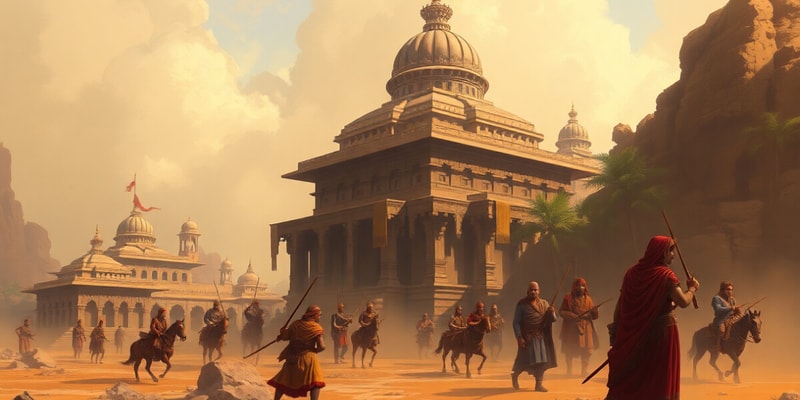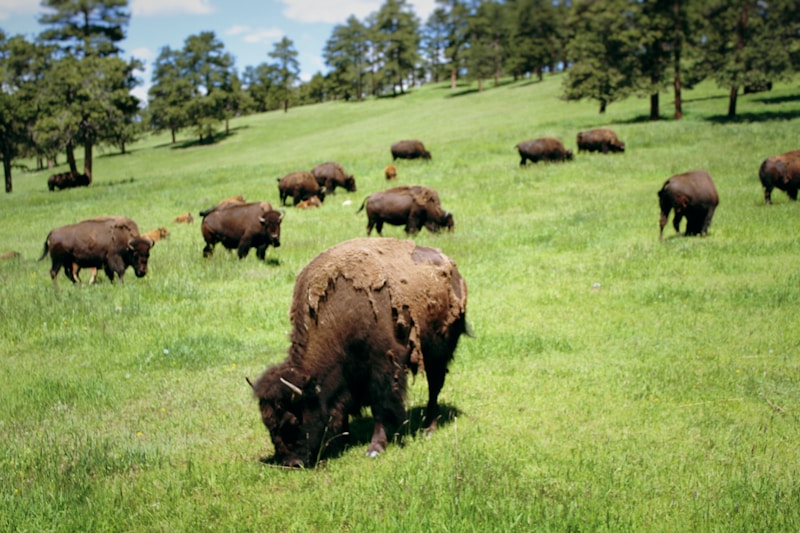Podcast Beta
Questions and Answers
What were the roles of officials in the Mauryan Empire?
Officials oversaw tax collection, irrigation inspections, and management of occupational groups.
Why was efficient communication important in the Mauryan Empire?
Efficient communication was vital for maintaining the empire, as travel required considerable planning and security.
How long did the Mauryan Empire last compared to other Indian historical periods?
The Mauryan Empire lasted about 150 years, which is relatively short in the context of Indian history.
What characteristics define a chief in the context of chiefdoms?
Signup and view all the answers
What was the significance of elephant capture procedures described in the Arthashastra?
Signup and view all the answers
What evidence suggests the size of the Mauryan army, and how is it viewed by modern historians?
Signup and view all the answers
Who founded the Mauryan Empire and when?
Signup and view all the answers
What inscription method did Asoka use to spread his messages?
Signup and view all the answers
Name one important source historians use to learn about the Mauryan Empire.
Signup and view all the answers
What message did Asoka's inscriptions consistently convey throughout his empire?
Signup and view all the answers
What were the five major political centers of the Mauryan Empire?
Signup and view all the answers
Which languages and scripts were mainly used for Asoka's inscriptions?
Signup and view all the answers
What significant political changes occurred around the sixth century BCE in India?
Signup and view all the answers
Who was Piyadasi and what does this name mean?
Signup and view all the answers
What are mahajanapadas and how many are commonly referenced?
Signup and view all the answers
What distinguished the rulership of some mahajanapadas from others?
Signup and view all the answers
What term refers to writings engraved on hard surfaces, often recording achievements?
Signup and view all the answers
What was the significance of the work done by James Prinsep in the 1830s?
Signup and view all the answers
Describe the meaning of 'Janapada' in the context of ancient India.
Signup and view all the answers
What new burial practices emerged in central and south India during the first millennium BCE?
Signup and view all the answers
What time period did Magadha rise to prominence as a mahajanapada?
Signup and view all the answers
List two natural resources that contributed to Magadha's agricultural productivity.
Signup and view all the answers
What military advantage did Magadha have that was vital for its power?
Signup and view all the answers
How did the Ganga River contribute to the development of Magadha?
Signup and view all the answers
Who were the ruthless kings credited with Magadha's power according to early writers?
Signup and view all the answers
What was the initial capital of Magadha?
Signup and view all the answers
What city became the later capital of Magadha in the fourth century BCE?
Signup and view all the answers
In modern historical explanations, what aspect besides agriculture is crucial for understanding Magadha's growth?
Signup and view all the answers
What does the term 'oligarchy' refer to in governance?
Signup and view all the answers
Which ancient civilization is mentioned as an example of oligarchy?
Signup and view all the answers
Study Notes
Mauryan Empire
- Officials oversaw land measurement, irrigation systems, army supplies, tax collection, and various occupations like blacksmiths and miners.
- Efficient communication was vital, involving land and river travel, requiring pre-planning and military security.
- The empire lasted approximately 150 years, with a large army of 600,000 foot soldiers, 30,000 cavalry, and 9,000 elephants.
- The army was divided into six subcommittees, responsible for navy, transport, provisions, foot soldiers, horses, and elephants.
Chiefs and Chiefdoms
- Chiefs were influential leaders, often hereditary, with special rituals, military duties, and dispute resolution.
- Chiefs received gifts, unlike kings who collected taxes.
- Southern Indian kingdoms like Chola, Cheras, and Pandyas were prosperous, described in early Tamil Sangam texts.
Capturing Elephants
- The Arthashastra outlines procedures for capturing elephants, involving forest guards, rearers, trainers, and boundary guards.
Early States and Economies
- Following the Harappan civilization, agriculture emerged in various regions, including the Deccan Plateau and Karnataka.
- Megalithic structures emerged in central and south India, often with iron tools and weapons.
- The sixth century BCE saw the emergence of early states, empires, and kingdoms, alongside changes in agricultural organization and the rise of new towns.
- Sources like inscriptions, texts, coins, and visual materials are used to understand these developments.
- Inscriptions are writings on hard surfaces like stone, metal, or pottery, recording achievements, activities, and ideas.
- Prakrit was the language used in early inscriptions, with variations in writing styles over time.
Magadha
- Between the sixth and fourth centuries BCE, Magadha became the most powerful mahajanapada.
- Factors contributing to Magadha's power include productive agriculture, iron resources, elephants, and convenient transportation via the Ganga River.
- Early writers attributed Magadha's power to ambitious kings like Bimbisara, Ajatasattu, and Mahapadma Nanda, and their ministers.
- Rajagaha (present-day Rajgir) was the initial capital, followed by Pataliputra (present-day Patna) in the fourth century BCE.
Oligarchy
- A form of government where power is held by a group of men.
The Sixteen Mahajanapadas
- These early states existed in the sixth century BCE, with names like Vajji, Magadha, Koshala, Kuru, Panchala, Gandhara, and Avanti.
- Most were ruled by kings, while some were oligarchies (ganas or sanghas) where power was shared.
The Mauryan Empire
- Emerged from Magadha, founded by Chandragupta Maurya around 321 BCE.
- Expanded control to Afghanistan and Baluchistan, with Asoka conquering Kalinga (present-day coastal Orissa).
- Sources include archaeological discoveries, contemporary accounts like Megasthenes', the Arthashastra, Buddhist, Jain, and Puranic literature, and Asoka's inscriptions.
- Asoka promoted dhamma, emphasizing respect for elders, generosity, kindness, and religious tolerance.
- The empire had five major political centers, including Pataliputra and the provincial centers of Taxila, Ujjayini, Tosali, and Suvarnagiri.
- Asoka's inscriptions suggest a uniform administrative system, but the extent of control across the empire varied.
- Language and scripts varied within the Empire, with Prakrit in most regions, Aramaic and Greek in the northwest, and the Brahmi script primarily used.
The Pandya Chief Senguttuvan
- Described in the Tamil epic Silappadikaram, visited a forest where people sang, danced, and brought gifts like ivory, fragrant wood, and deer hair.
Divine Kings
- Kushanas, who ruled from Central Asia to Northwest India, associated themselves with deities.
- Colossal statues of Kushana rulers in shrines suggest godlike status, potentially inspired by Chinese rulers.
- The title devaputra ("son of god") was adopted by many Kushana rulers.
Samantas
- Larger states like the Gupta Empire relied on samantas, men who controlled resources and provided military support.
- Powerful samantas could become kings, while weak rulers remained subordinate.
- Sources for Gupta history include literature, coins, and inscriptions, including prashastis (poetic accounts praising kings).
The Prayaga Prashasti
- Offers pronouncements of rulers, but not necessarily literal accounts.
- Samudragupta is described as a powerful and compassionate ruler with no rivals.
Studying That Suits You
Use AI to generate personalized quizzes and flashcards to suit your learning preferences.
Description
Explore the Mauryan Empire's administrative efficiency, military organization, and the role of chiefs in southern Indian kingdoms. Discover insights from Arthashastra regarding elephant capture and the significance of communication in governance. This quiz highlights the unique dynamics of leadership and military strategy in ancient India.




